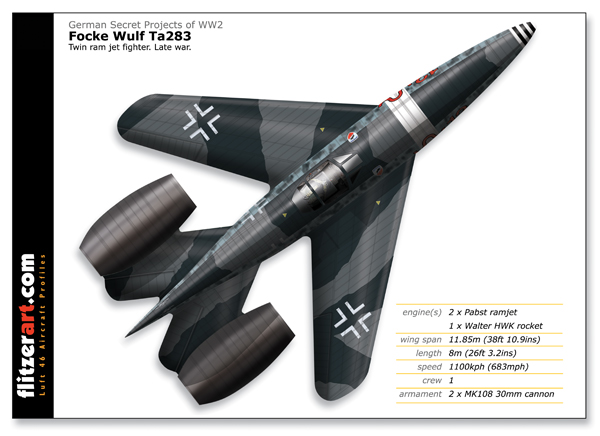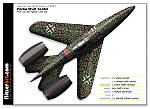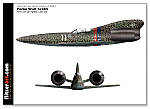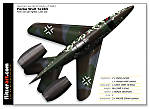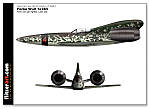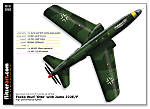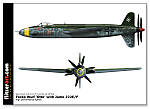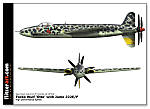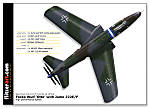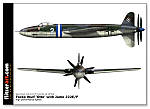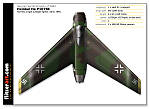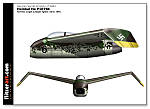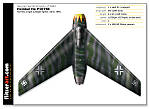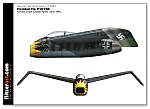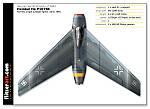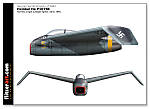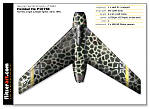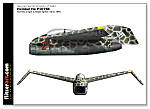German Secret Projects of WW2 Vol. 4
4
Comments
Focke Wulf Ta283
The Focke Wulf Ta283 was a design for a ramjet-powered fighter. It had a long slender fuselage and pointed nose. The cockpit was faired in to the leading edge of the large vertical fin. It was planned to use a Walter HWK rocket engine for take-off and two Pabst ramjets once operating speed was reached. The 45 degree swept wings were mounted low on the fuselage. The ramjets were located on the ends of the swept tailplanes to minimise airflow disturbance around the tail. Armament would have been provided by a pair of MK 108 30mm cannon.
Focke Wulf with Jumo 222 E/F
Looking remarkably similar to the Dornier P247 design, Focke Wulf produced two proposals for the high performance fighter requirement of July 1944. The two designs were for all intents and purposes, the same with each designed to accommodate a different powerplant. These being the Argus As413 and as shown here the Jumo 222E/F. The engine was mounted in the aft portion of the fuselage driving a pusher prop at the cruciform tail via a shaft. The radiator was fuselage mounted with a fan drawing air from wing root intakes and exhausting through an annular slot. The design also featured swept wings and a tricycle undercarriage.
Heinkel P1078C
During January and February 1945, Heinkel worked on this advanced looking proposal which resembled the Blohm and Voss P212. The design was of a tail-less configuration with wooden swept back wings and downturned wing tabs intended to function as the tailplane. The all-metal fuselage was rather squat and the nose, rectangular in cross section. The design gave many problems to the designer, Siegfried Gunter arranging all the components to fit into such a small compact fuselage. The RLM decided that flight characteristics would have been unsatisfactory and there were doubts about the nose wheel housing, after which Heinkel ceased all further work on the design.
The Focke Wulf Ta283 was a design for a ramjet-powered fighter. It had a long slender fuselage and pointed nose. The cockpit was faired in to the leading edge of the large vertical fin. It was planned to use a Walter HWK rocket engine for take-off and two Pabst ramjets once operating speed was reached. The 45 degree swept wings were mounted low on the fuselage. The ramjets were located on the ends of the swept tailplanes to minimise airflow disturbance around the tail. Armament would have been provided by a pair of MK 108 30mm cannon.
Focke Wulf with Jumo 222 E/F
Looking remarkably similar to the Dornier P247 design, Focke Wulf produced two proposals for the high performance fighter requirement of July 1944. The two designs were for all intents and purposes, the same with each designed to accommodate a different powerplant. These being the Argus As413 and as shown here the Jumo 222E/F. The engine was mounted in the aft portion of the fuselage driving a pusher prop at the cruciform tail via a shaft. The radiator was fuselage mounted with a fan drawing air from wing root intakes and exhausting through an annular slot. The design also featured swept wings and a tricycle undercarriage.
Heinkel P1078C
During January and February 1945, Heinkel worked on this advanced looking proposal which resembled the Blohm and Voss P212. The design was of a tail-less configuration with wooden swept back wings and downturned wing tabs intended to function as the tailplane. The all-metal fuselage was rather squat and the nose, rectangular in cross section. The design gave many problems to the designer, Siegfried Gunter arranging all the components to fit into such a small compact fuselage. The RLM decided that flight characteristics would have been unsatisfactory and there were doubts about the nose wheel housing, after which Heinkel ceased all further work on the design.
Comments
Many thanks Rowan
for all your hard work in getting it up and running.
Cheers
Peter
MAR 29, 2009 - 08:40 PM
Looks great as always, Peter. Very nice inspiration for luft '46 projects. Especially with the campaign coming on the subject.
Thanks for sharing
MAR 31, 2009 - 04:11 PM
Hi Peter,
Fantastic work as always. By the way, how many time do you spend on such a collection of profiles? It must take ages...
Thanks Rowan for the editing work. Knowing how difficult it is to work with the gallery at the moment, I can imagine a lot of modelling time went into this feature.
Jean-Luc
MAR 31, 2009 - 05:28 PM
Phew...how long do I spend on these?
Approximately about 12 hours or more a week. I started this set immediately after the last WW2 British Secret Project V3 set was put up on site mid December 08, so to do the 60+ plates its taken me a little more than 3 months.
It's always the first sample of each subject that takes the most time. Once one has been done it's just a matter of changing the markings and camo layers.
Many thanks
Peter
APR 01, 2009 - 02:04 AM
Copyright ©2021 by Peter Allen. Images also by copyright holder unless otherwise noted. The views and opinions expressed herein are solely the views and opinions of the authors and/or contributors to this Web site and do not necessarily represent the views and/or opinions of AeroScale, KitMaker Network, or Silver Star Enterrpises. Images also by copyright holder unless otherwise noted. Opinions expressed are those of the author(s) and not necessarily those of AeroScale. All rights reserved. Originally published on: 2009-03-29 00:00:00. Unique Reads: 19417




